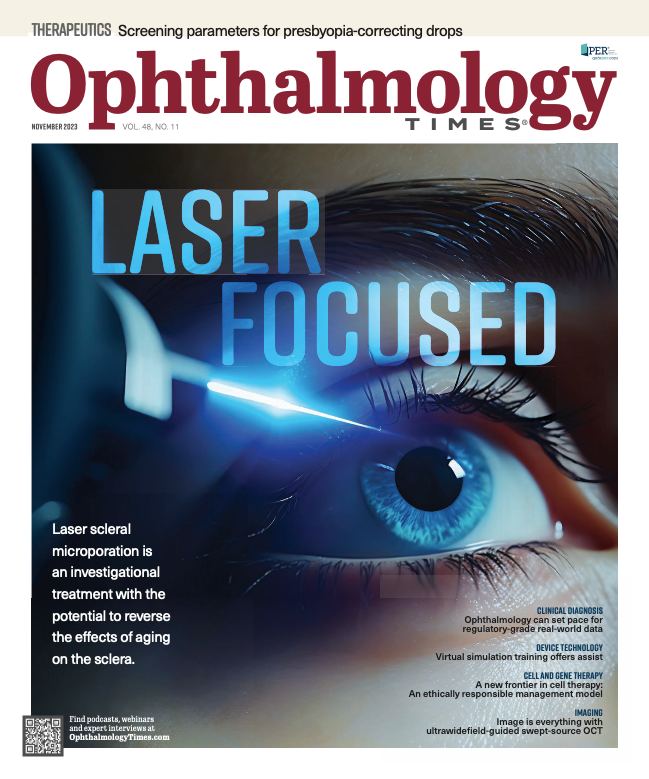Ophthalmology can set pace for regulatory-grade real-world data
Ophthalmic data are well suited to the demands of regulatory-grade use cases.
(Image Credit: AdobeStock/natali_mis)

Ophthalmology is well positioned to help the FDA's Advancing Real-World Evidence Program unlock its fullest potential. Few, if any, other specialties or subspecialties provide the level of data quality required for these regulatory-level use cases.
Data quality in this context is broadly objective. It combines a level of highly precise, standardized measures and scoring systems, detailed coding structure, and the critical mass of patients necessary to support reliable simulations based on the real-world experience of millions of patients. Despite this seemingly optimal environment for real-world evidence (RWE) to flourish, ophthalmology often seems to trail other specialties when it comes to seeking label expansions and supporting other regulatory decisions with RWE.
According to our published research,1 ophthalmic data are uniquely well suited to the demands of regulatory-grade use cases. Specifically, the research demonstrated that it is possible to use real-world data (RWD) to replicate the primary outcome measures of 2 large-scale randomized controlled trials in ophthalmology—the phase 3 VIEW 1 and VIEW 2 (VIEW 1/2) pivotal trials. VIEW 1/2 led to the approval by the FDA of aflibercept (Eylea; Regeneron) for the treatment of neovascular age-related macular degeneration (nAMD) in 2011.
What these findings reveal is that this level of high-quality RWD can consistently find patients in real-world clinical settings that mirror those who participated in clinical studies, and—when we follow them throughout their health care journeys—the real-world patients experienced outcomes very similar to those of the patients in the trial. This unlocks huge opportunities for clinicians, academic researchers, life sciences companies, and regulators.
Incorporating RWE into the clinical trial workflow
Consider, for example, the huge gains in efficiency that could have been realized if the RWE we analyzed in our research was integrated into the VIEW 1/2 randomized control trials. Those trials, which were conducted in parallel, were incredibly ambitious in scope. All told, the trials evaluated 1632 subjects over the course of 52 weeks across the US, Europe, Asia, and Latin America and ultimately helped pave the way for an important new drug approval.
By contrast, the core research algorithms used in our RWE version of the trials were able to be programmed in days using patient data contained in the American Academy of Ophthalmology IRIS (Intelligent Research in Sight) Registry, which is among the largest medical specialty registries, containing deidentified patient data from 79 million unique patients and collected from more than 16,000 participating clinicians. Even better, once we applied the same inclusion and exclusion criteria that were used in the VIEW 1/2 studies, we were able to immediately identify a universe of 4779 patients who fit the patient profile for the study.
Let’s put that into perspective for a moment. Using traditional methods, the multicenter, double-masked, randomized, parallel group, active treatment–controlled VIEW 1/2 trials would have spent several months developing a site selection strategy, identifying eligible patient populations, engaging with clinicians, and aligning clinical trial resources in sites around the globe before the actual trial could even start. We were able to find roughly 3 times the number of eligible patients in a matter of days by comparing the VIEW 1/2 study cohorts with the real-world journeys of patients with nAMD captured in the IRIS Registry. Effectively, we were able to create a synthetic control arm that replicated the experience of the trial participants using external patient-level data.
Best of all, when we tracked those patient cohorts over time, evaluating their real-world interactions with the health care system, monitoring which prescriptions they were taking, and cataloging the detailed clinical measures and accompanying notes that corresponded with that care, we found results that replicated the outcomes of the formal studies.
That is not to say that RWE should immediately replace randomized clinical trials. However, it does introduce some fascinating options for dramatically expanding and improving upon the status quo.
Similarly, during the study itself, what if a synthetic control arm were created to track the real-world experiences among the 4779 eligible patients identified in the RWE who were not participating in the clinical study? What additional clinical insights could be gathered from that group? Going even deeper, what kinds of variance might we see in that data set based on socioeconomic, geographic, demographic, and other variables that might not show up in a traditional clinical trial population? The research power of this type of broad-based view of the entire patient landscape would unlock a new layer of understanding that was never before possible.
That additional layer of granularity and wider view of the complete patient population would also pay enormous dividends in the postapproval phase, allowing researchers to conduct detailed comparative effectiveness analyses and zero in on optimal markets to promote their newly approved therapy.
Despite the fact that ophthalmic RWE is uniquely well suited to these types of analyses, we’ve yet to see it used in any significant capacity in the regulatory review and approval process. By contrast, Pfizer’s breakthrough breast cancer therapy palbociclib (Ibrance) won a label expansion after the company worked closely with the FDA on research based largely on RWE. Astellas’ tacrolimus (Prograf), an immunosuppressant drug used to prevent organ rejection post lung transplant, received FDA approval based on a noninterventional study that used RWE from the US Scientific Registry of Transplant Recipients.
Ophthalmology should have a bigger role in this conversation.
It will be critical, as the entire clinical research community—not just ophthalmology—continues down this path of infusing RWE into all aspects of the research, review, approval, and commercialization process, that we scrutinize the data and hold data providers to the highest standards of accuracy, completeness, and reliability.
Theodore Leng, MD, MS
E: vision.md@gmail.com
Leng is a medical adviser at Verana Health, director of clinical and translational research at the Byers Eye Institute at the Stanford University School of Medicine Department of Ophthalmology, and medical informatics director for ambulatory specialties at Stanford Health Care in Palo Alto, California.
Reference:
1. Gallivan MD, Garcia KM, Torres AZ, et al. Emulating VIEW 1 and VIEW 2 clinical trial outcome data using the American Academy of Ophthalmology IRIS Registry. Ophthalmic Surg Lasers Imaging Retina. 2023:54(1):6-14. doi:10.3928/23258160-20221214-01
